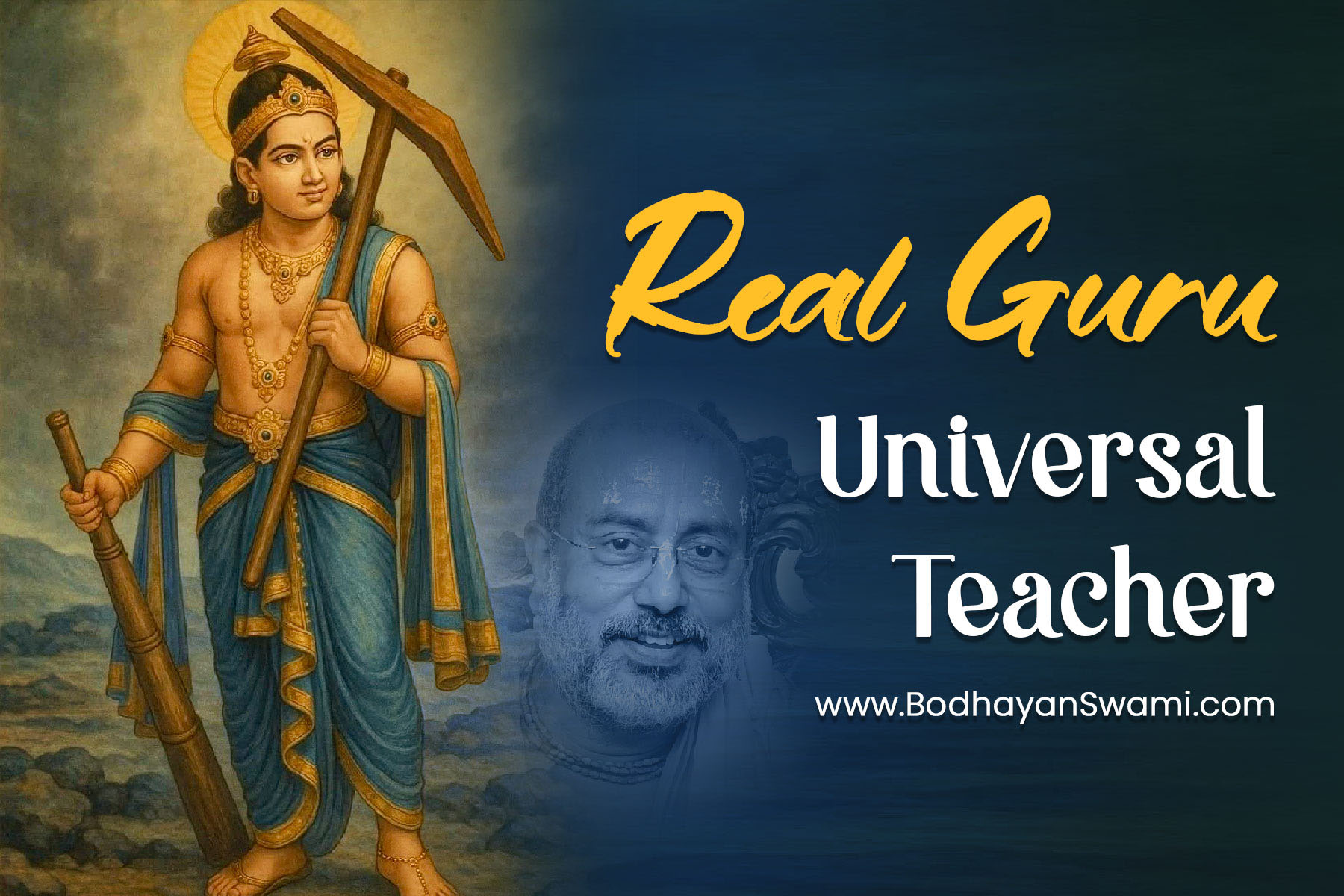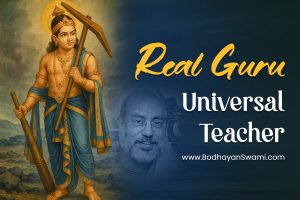Real Guru – Universal Teacher
Our previous teacher, HDG Sacidananda Sri Srila Bhaktivinode Thakur, mentioned in one of his writings that there are 13 groups known as apa sampradayas who are misleading the teachings of Lord Chaitanya. After Lord Chaitanay’s physically left for His abode, these 13 apa sampradays called Aula, baula, kartabhaja, neda, daravesa, sani, sahajiya, sakhibheki, smarta, jata-gosani, ativadi, cudadhari, gauranga-nagari, started to mislead people in the name of spirituality.
The thirteen “apa-sampradayas” (corrupted lineages) are groups that deviated from the Gaudiya Vaishnava tradition after Lord Chaitanya’s disappearance. They are considered deviations because they misinterpret or contradict the core teachings of the Gaudiya Vaishnava lineage, in particular the Sri Brahma-Madhva-Gaudiya Saraswata Sampradaya. His Divine Grace Srila Bhakti Vinode Thakur explained the characteristics of their practice as follows:
Aula, Baul, Kartabhaja: These groups often emphasise emotional or ecstatic practices, sometimes with a questionable interpretation of devotional service.
13 Groups – Apa Sampradayas:
- Aaul: The followers of this group see themselves as God. They enjoy the sensual relationships with many types of women, like their own wives, prostitutes, widows, another man’s wife, etc. For their physical satisfaction, there is no regard for rules and regulations.
- Baul: There is little difference between Aula and Baul. The followers of Baul are greatly attached to sensual pleasures. They believe that the most worshipful Sri Sri Radha Krishna is situated in the material gross body, and whatever is in the universe is within the gross body of human beings. They also believe that Brahma, Vishnu, Maheswar, Vaikuntha, and Goloka-Vrindavan are all situated within the material body of human beings. They feel that the divine love of Radha-Krishna is in the illicit relationships between men and women. Therefore, Srila Bhaktivinode Thakur says – Sohej Vajan Korchen Mamu, Sange niye Paper bala; Sakhi vabe vojchen tare, Nije hoe Nandalala.They eat semen, blood, urine, and stool, and consider this to be an austere practice.
- Kartabhaja: Aual Chand was the founder of this community. The followers of this sect consider the spiritual master to be God and Gauranga. They do not practice the tenets of true devotion; never maintain righteousness; and are considered to be in a state of illusion.
- Nera: Shaven-headed persons are called Nera. Followers of this sect shave their heads during the initiation ceremony. They put a tilak on the forehead and observe fasting during the Ekadashi vow, but do not maintain righteousness according to the scriptures.
They eat fish and associate with women. They offer food in a small earthen pot to the souls of the dead and believe that the dead achieve liberation in this way. They ignore the scriptures, the ideals and teachings of Sri Chaitanya Mahaprabhu and the Goswamis.
- Darbesh: The followers of this lineage conceal their identity. To escape prison, Srila Sanatan Goswamipad offered 7000 golden currency notes to the guard and told him that he would dress himself as “darbesh’ and go to Macca. Not understanding the true purpose of Srila Sanatan Goswamipad, people artificially decorate themselves as ‘Darbesh’ wearing coral coloured gown and garland. They remain unshaven and move about here and there and ignore the principles of Sanatan Dharma (eternal religiosity; now people call this pure devotional practice as prescribed by the six-Goswami’s; those six Goswami’s names are as ‘Rupa’, ‘Sanatana’, ‘Srijiva’, ‘Gopal Bhatta’, ‘Raghunath Bhatta’ and ‘Raghunatha Das’. The teaching of the six Goswamis is presently referred to as ‘Sanatan Dharma.
- Snai: The followers of Snai are like Baula. The advisers of this sect are Alok Snai, Khirod Snai, Garva Sna, and Nanok Snai. They follow the principles of non-Hindus.
- Sahajia: They try to understand spirituality with the help of material knowledge. They give importance to the practices that centre around the material body because they see that the Absolute Truth, i.e., the Lord, situates Himself in the material body. According to them, every man is the representative of Sri Krishna, while every woman is the delegate of Srimati Radharani. They don’t believe in the eternal transcendental nature of the birth and activities of Lord Krishna. The people of this community think that Vaishnavism is a caste, the spiritual master is an ordinary human being, and prasadam is regular food.
- Sakhibheki: This sect thinks the material body is like Sakhi or Gopi, and so they wear a saree and bangles, apply ‘sindoor’ (red colour powder form which Hindu women use on top of their forehead after marriage), and keep long hair tied in a bun. Sometimes they decorate themselves as Lalita Sakhi, sometimes as Visakha Sakhi, and sometimes as other sakhis. Pretending to offer service to Lord Krishna.
- Smarta: Raghunandan Bhattacharya lived in Nabadwip. Is the founder of this community. He prescribed the rules of the demons, which were imaginary. The Kulin (rigid or orthodox Brahmin) residents of Nabadwip-Dham were following these rules.
- Jāt Gosnai: Those who accept the word “Goswami” as merely a title are called Jat Gosnai. The word ‘Go’ means Senses, and the word ‘Swami’ means Lord or the controller of the senses. Those who have control of the physical sense organs are eligible to use the word ‘Goswami’ properly. Jat Gosnai Community mainly deals in mantra. The spiritual master is in serial Succession, i.e., the son of the spiritual master will be the next spiritual master. They accept non-vegetarian food and intoxicants.
- Atibari: A resident of Utkal State named Jagannath Das was the preacher of this Sect. This sect makes unnecessary flowery enhancements to the teachings of Lord Chaitanya.
- Churadhari: This Sect wears crowns on the head, thinking themselves as Krishna. Imitating playing the flute like Krishna. They engage in adultery and believe in the same principles as Baula.
- Gauranga Nagari: The followers of this sect decorate Sri Gour Sundar like Lord Krishna. They place a flute in His hand and add a peacock feather to the crown. They believe that since Gour Sundar is the combined form of Radha and Krishna, they should dress Lord Chaitanya as Krishna and sometimes Radha as Krishna for increased mellow. In “Chaitanya Bhagavat,” Srila Vrindavan Das Thakur states,
Eai moto chapolol Koren Soba mone, Sobe stree matro na dekhen Dristicone.
Stree heno nam probhu ei abotare, Shraban na Korila, bidita Samsare,
Atoab yoto mahamohim Sokole, Gauranga nagor heno stob nahi kare ||
Though claiming to spread Lord Chaitanya’s loving mission and to establish a mood of devotional service to the Lord, these groups instead encourage their followers to focus on self-love. Among them, the Kartabhaja line is particularly notable. Its followers view the guru as an incarnation of God and blindly follow whatever the guru says for his satisfaction. In doing so, they neglect the worship the Supreme Lord and His internal pleasure potency, Srimati Radharani. Other Divine Forms such as Baladeva, Jagannath, Subhadra Devi, and Sudarshan are neglected, even Krishna-Balaram and the authentic disciplic lineage as taught by Srila Prabhupada Bhaktisiddhanta Sarasvati Goswami Thakur, is ignored.
We must approach the ultimate master, Sri Krishna, through the parampara (disciplic succession). I am an insignificant disciple of my spiritual master, His Divine Grace Srila Bhakti Pramode Puri Goswami Thakur, my grand spiritual master, HDG Srila Bhaktisiddhanta Sarasvati Thakur, and my great-grand spiritual master, HDG Kula Chuda Mani Srila Gaura Kishore Das Babaji Maharaj, and so on. The process is to worship them and, by their mercy, gradually reach our ultimate worshipable Lordships, Sri Sri Radha-Krishna.
However, the Kartabhaja teach their followers to worship only the guru as the ultimate object of devotion. As such, their followers keep only their guru’s picture on the altar. They do not place any images or vigrahas (deity forms) of the ultimate guru Sri Krishna and Srimati Radharani, or of Baladeva, Jagannath, Subhadra, and Sudarshan.
They have misconstrued the following verse:
Gurur Brahmā Gurur Viṣṇur Gurur Devo Maheśvaraḥ
Guruḥ sākṣāt Paraṁ Brahma tasmai śrī gurave namaḥ
They interpret this verse to mean that the individual guru is Brahma, Vishnu, Mahesh (Shiva), and the Supreme Brahman. However, the actual meaning is that the ultimate guru is Krishna Himself. His manifestation in the mode of passion is Brahma; in the mode of goodness, Vishnu; in the mode of ignorance, Shiva (Maheshvara). Krishna is the Param-Brahma, the Supreme Personality of Godhead. I humbly offer my obeisance to that Krishna.
In the Kartabhaja tradition, however, the sole figure of worship is the guru. Thus, followers are taught to keep only the guru’s image on the altar. In doing so, they follow the guru’s personal instructions rather than the teachings of parampara and the shastra, thereby becoming Kartabhajas.
Such apa-sampradayas perceive the guru as merely an individual, but the guru is the representative of the absolute truth, and that absolute truth is none other than Sri Krishna, the Supreme Personality of Godhead.
Krishna rakshati jagat trayam guru –
Krishna protects the three worlds; therefore, He is the guru.
Whoever represents Krishna is a guru, and the degree to which that guru is dear to Krishna determines the extent of their spiritual authority. Srila Vishwanath Chakrabarty Pad – the ‘rasik acharaya’ mentions in Guru Ashtakam
sākṣād-dharitvena samasta-śāstrair, uktas tathā bhāvyata eva sadbhiḥ;
kintu prabhor yaḥ priya eva tasya, vande guroḥ śrī-caraṇāravindam||
All the scriptures declare the spiritual master to be non-different from Lord Hari. The saintly devotees also acknowledge him as such. However, he is worshipped because he is very dear to the Lord.
Thus, Srila Vishvanatha Chakravarti Thakur explains that the guru possesses divine authority to the extent that he is dear to Krishna. The guru is honoured not as the Supreme but as the beloved representative of the Supreme.
There are clear differences between the spiritual master and the Supreme Lord. We know that Krishna is the creator of the universes, but the spiritual master is not. Krishna exists before the creation of the universe, He exists in the present, and He will continue to exist after its annihilation. As Brahma explained, “sat” means eternal—Krishna is sat, but the guru, as an individual embodied soul, is not eternal in the same way.
The person whom some may mistakenly think to be Param Brahma (the Supreme Brahman) also eventually leaves his material body, whereas Krishna is eternal and transcendental. Krishna is always youthful; He does not age. In contrast, the guru grows old with time. Krishna has no facial hair, but a guru may be seen with a beard or moustache. Krishna is the controller of Maya, but the guru is not; he is a servant of Krishna and can be influenced by Maya unless fully surrendered and empowered.
If Krishna becomes displeased with us, the guru can appeal on our behalf and pacify Him. But if the guru is displeased, Krishna may not interfere to pacify the guru. As a Bengali saying goes:
Guru ruṣṭo hole Krishna rākhite nā pāre, Krishna ruṣṭo hole guru rākhite pāre.
If the guru is angry, even Krishna cannot protect you; But if Krishna is angry, the guru can protect you. What are the signs that someone is truly dear to Krishna? In the 12th chapter of the Bhagavad Gita, Lord Krishna clearly describes the qualities of His dear devotee:
yo na hṛiṣhyati na dveṣhṭi na śhochati na kāṅkṣhati
śhubhāśhubha-parityāgī bhaktimān yaḥ sa me priyaḥ
samaḥ śhatrau cha mitre cha tathā mānāpamānayoḥ
śhītoṣhṇa-sukha-duḥkheṣhu samaḥ saṅga-vivarjitaḥ
tulya-nindā-stutir maunī santuṣhṭo yena kenachit
aniketaḥ sthira-matir bhaktimān me priyo naraḥ
Those who are unaffected by joy and sorrow, who neither envy nor lament, who renounce both good and bad karma, and are deeply devoted to Me—they are dear to Me.
Those who are equal to friend and enemy, who remain steady in honour and dishonour, in heat and cold, happiness and distress, who are free from attachment—such persons are very dear to Me. One who is content, silent, steady-minded, lives without fixed residence, and whose heart is fixed on Me in devotion—such a devotee is most dear to Me.
These qualities reflect a deep devotional mood. Whenever there is an opportunity to serve Krishna, one must be eager and quick to do so. A devotee who serves with such sincerity, without duality or discrimination, is truly dear to the Lord.
Unfortunately, due to widespread misconceptions, the qualifications of a spiritual master are often judged by material standards—such as owning large temples, having many followers, or managing opulent deities. This materialistic outlook is now increasingly found even among those who claim to follow Lord Chaitanya’s mission under the guidance of Srila Bhaktisiddhanta Saraswati Goswami Thakur. Such thinking mirrors the principles of the Kartabhaja sect, which misrepresents the spiritual path.
My grand spiritual master, His Divine Grace Srila Bhaktisiddhanta Saraswati Goswami Thakur, once clearly said in a harikatha (spiritual discourse) that:
“If a guru thinks, ‘I am a guru’, then the first syllable ‘gu’ becomes ‘ga’.
The word ‘guru’ then becomes ‘garu’ (cow, in Bengali)—an animal.”
This strong statement emphasises that ego and pride are disqualifications for a spiritual master.
Srila Prabhupada also used to say that those who accepted initiation from him were “my friends who protect me from various material dangers” (‘bipod uddharan bandhav’). He would address everyone respectfully using the word “apni”, and he would offer obeisances to others. Srila Prabhupada never considered himself a guru in a proud or authoritative way; he always saw himself as a humble servant of the servant of the servant of the servants in Lord Chaitanya’s mission. (Chaitanya Charitāmṛta, Madhya-līlā 19.151)
brahmāṇḍa bhramite kona bhāgyavān jīva
guru-kṛṣṇa-prasāde pāya bhakti-latā-bīja
Out of the countless living entities wandering throughout the universe, only a very fortunate soul, by the mercy of Krishna, receives the opportunity to associate with a bona fide spiritual master. By the combined mercy of both Krishna and the spiritual master, that fortunate soul receives the seed of the creeper of devotional service (bhakti-latā-bīja).
The ultimate guru is Krishna, and His mercy flows to us through the paramparā—the disciplic succession—via the bona fide spiritual master. A genuine guru is completely free from all unwanted material desires (anarthas) and whose mind is firmly fixed on the Divine Couple, Śrī Śrī Rādhā and Krishna, and their loving service.
The Puranas offer a profound definition of who is qualified to be a Guru:
kṛpā-sindhuḥ susampannaḥ,
sarva-śuddho sarva-vidyā-viśāradaḥ, guruḥ proktaḥ
(Hari-bhakti-vilāsa 1.35; Viṣṇu-smṛti-vacana)
A guru is described as:
Kṛpā-sindhuḥ – an ocean of mercy,
Susampannaḥ – one who is spiritually accomplished and fully established in their eternal position, free from all material demands,
Sarva-śuddhaḥ – completely pure in character and behaviour
Sarva-vidyā-viśāradaḥ – thoroughly learned in all branches of spiritual knowledge.
In addition, such a guru is a well-wisher to all living beings (niṣpr̥ha), having no personal expectations or selfish desires from the service they render. They embody the 26 qualities of a pure Vaiṣhnava, are expertly balanced in behaviour, and are constantly engaged in service to Lord Hari—never lazy, inattentive, or distracted.
They can render all types of devotional service (externally and internally), make wise and spiritually sound decisions, clear the doubts of sincere disciples through realised knowledge, and serve selflessly, solely for the pleasure of Śrī Hari. Such a person is truly qualified to take the exalted position of guru.
Chaitanya Caritamrita 2/22/24
Now we know the qualifications of a guru. Not just anyone can be a guru. A guru must possess the qualities mentioned in our scriptures, and we must remember that the ultimate guru is Krishna Himself—“Krishna rakshati jagat trayam guru.”
As stated in the Sri Chaitanya Charitamrita:
“Krishna nitya das jiva taha bhuli gela
ei dose maya tare goloai bandhila.”
As soon as the living beings forget that we are the eternal servants of Krishna, Maya Devi binds us by the neck to this miserable and mundane world. This material world, which we have become attached to and are reluctant to leave, is like a prison, and we are the prisoners. We are convicted because we have lost our relationship with Krishna.
What is that relationship? That we are His eternal servants. Krishna is the eternal Lord of all living entities. When we forget this relationship, we face many difficulties.
Let’s consider an analogy: Suppose there is a prison with thousands of inmates. One day, the governor visits and tells the prisoners that he will listen to their problems and try to solve them. One by one, the prisoners approach him: one complains about the poor food quality, another asks for mosquito nets, and another says the prison doesn’t provide enough milk. The governor listens and reassures them that their issues will be addressed.
Finally, the last prisoner comes forward and says, “I have one problem—can you solve it?”
The governor replies, “So far, I’ve solved everyone’s problems. I will solve yours, too.”
The prisoner says, “I’m not happy here. I want to go back home.”
This is our condition. Under the illusion of material energy, we are trying to improve our situation here, not to leave this place. Everything we do binds us further. Our main problem is that we are in this prison—and we need to get out.
To deliver us, the Supreme Lord appeared in the form of Sri Krishna Chaitanya Mahaprabhu. He taught that the way to free ourselves from all material attachments is by chanting the Hare Krishna Mahamantra. Then the realisation will awaken in our hearts that we are the eternal servants of the Lord, not of Maya.
Therefore, we must find a guru who is free from all material attachments, who seeks neither recognition, name, fame, or adoration, and who has no material desires.
If we forget that Krishna is the ultimate guru, what will happen?
“kṛṣṇa bhuli’ sei jīva anādi-bahirmukha
ataeva māyā tāre deya saṁsāra-duḥkha”
As soon as we forget Krishna, lifetime after lifetime, we become servants of Maya. She entices us with the illusion that happiness lies in material achievements—academic success, wealth, or sensory enjoyment. Our true identity is not the body—it is the soul. We must centre our lives around Krishna.
The moment we forget Krishna, Maya Devi pulls us in various directions, distracting us with false hopes of happiness. Who can save us from this trap? Only a bona fide guru, the true representative of Krishna, appointed by our spiritual lineage and free from all material attachments. That person is a real guru.
When we take shelter of such a guru, we can be delivered. The purpose of accepting a guru is to free ourselves from material attachments that only cause suffering.
We see today that children often don’t listen to their parents, even though parents give them love and affection—this results in distress. Some people own vast properties but cannot maintain them, yet they cling to them. When the properties are lost, they suffer. Maya keeps pulling us in with the illusion of happiness, but we end up in pain.
However, a bona fide spiritual teacher will guide us in the only direction that leads to true peace, love, and bliss—the lotus feet of Krishna. That is the ultimate goal we must establish in our lives. We should never oppose Krishna or His devotees, especially our guru.
“kṛṣṇa-bahirmukha hañā bhoga-vāñchā kare
nikaṭa-stha māyā tāre jāpaṭiyā dhare”
As soon as we forget or turn away from Krishna, Maya Devi captures us from behind and pulls us toward material illusions. Eventually, we suffer. Our true aim is eternal bliss—not temporary pleasures.
Whatever little happiness we feel in this world is fleeting. Srila Bhaktivinoda Thakur explains in Chaitanya Shikshamrita:
“We have many demands and much distress. When we temporarily move away from them,
we feel a little happiness, but soon we are captured again.”
My spiritual master, His Divine Grace Srila Bhakti Pramode Puri Goswami Thakur, used to say that what initially seems to make us happy ultimately brings us distress. This is Maya’s trickery—we are trapped by it.
We must sincerely try to follow in the footsteps of the bona fide devotees of Krishna—the true gurus. I am striving to follow the example and teachings of my guru-varga:
HDG Srila Bhakti Pramode Puri Goswami Thakur (initiating spiritual master), HDG Srila Bhakti Dayita Madhava Goswami Maharaj, HDG Srila Bhakti Goura Vaikhanas Goswami Maharaj, HDG Srila Bhakti Rakshak Sridhar Dev Goswami Maharaj, HDG Srila Bhakti Prajnan Keshav Goswami Maharaj, HDG Srila Bhakti Vedanta Swami Goswami Maharaj, HDG Srila Bhakti Kumud Santa Goswami Maharaj, HDG Srila Bhakti Hridoy Bon Goswami Maharaj, HDG Srila Bhakti Kusum Shraman Goswami Maharaj, and HDG Srila Bhakti Vilas Tirtha Goswami Maharaj.
All these exalted personalities are my worshipful masters, and my grand-spiritual master, the founder-acharya of the Gaudiya Math, HDG Srila Bhaktisiddhanta Saraswati Goswami Thakur, is my eternal guide.
I am trying to follow in their footsteps, though I am not yet qualified. I am only an aspiring follower. I humbly beg at their lotus feet. Please forgive all my offences. Grant me the strength to remain tolerant, to give due respect to all living beings, to sincerely chant the Hare Krishna Mahamantra, and to deliver myself from this miserable, mundane world.












